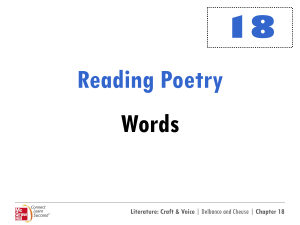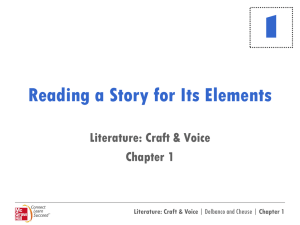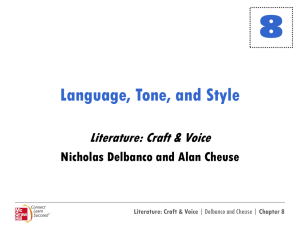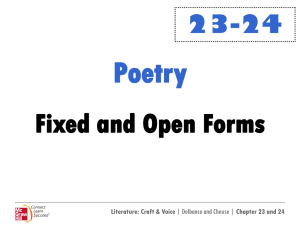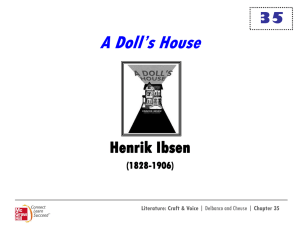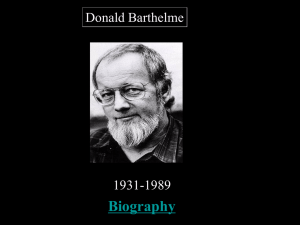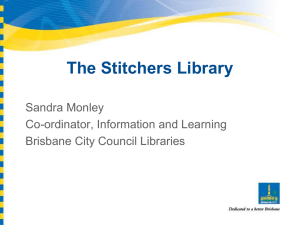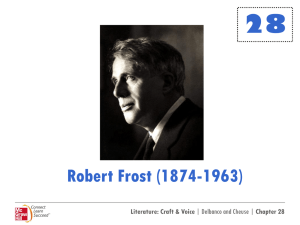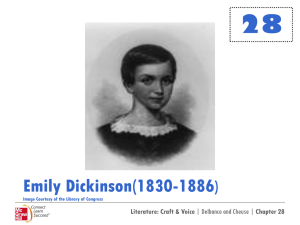The American West
advertisement
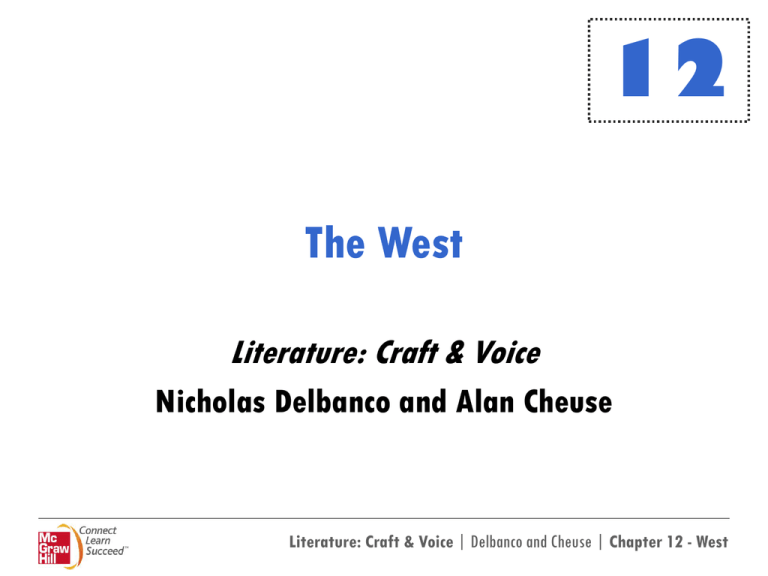
12 The West Literature: Craft & Voice Nicholas Delbanco and Alan Cheuse Literature: Craft & Voice | Delbanco and Cheuse | Chapter 12 - West The West Consider how the following facts have shaped the creative works that have emerged from the West: The West is the largest region of the United States and most geographically diverse. There are vast open spaces, deserts, grazing lands, lush farming valleys, and mountains. The West is the last region of the continental United States to be settled. Historically, the West was formed from the Louisiana Purchase of 1803, land ceded by Great Britain in 1818, land acquired when the Republic of Texas joined the U.S., additional land ceded by Britain in 1846 and Mexico in 1848, and land included in the Gadsden Purchase of 1853. In some western states, cities compete with farms and ranches as centers of commercial and cultural experience. Americans have long seen the West, particularly California, as a kind of promised land, where they could recreate their lives. Literature: Craft & Voice | Delbanco and Cheuse | Chapter 12 - West Old West vs. New West The American frontier moved gradually westward after the first white immigrants settled on the Eastern seaboard in the 1600s. The "West" was defined as that area just beyond established boundaries. It has long been romanticized as a place of freedom and individuality, out of the reach of restrictions, a place where the individual could realize and test himself. Ingrained in the American consciousness is the image of the cowboy and the settler with their wagon trains pushing forward. Consider the final lines of Huck Finn in Mark Twain’s masterpiece: “But I reckon I got to light out for the Territory ahead of the rest, because Aunt Sally she’s going to adopt me and sivilize (sic) me and I can’t stand it. I been there before.” The image of the West has grown more ambiguous in recent years. Literature and film are less certain of the good, morally upright settler taming the landscape and more aware of a growing society’s willingness to exploit natural resources and less empowered peoples. A sense of loss and disconnect shapes much of the writing that has emerged from not just Native American writers but others as well. Literature: Craft & Voice | Delbanco and Cheuse | Chapter 12 - West Today, the West is diverse, and not just geographically. Consider William Kittredge’s statement: “Somebody says, ‘How are things in Montana?’ And I’m tempted to say, ‘Which Montana are you asking about?’ I can name about 30 for you. There’s one made up of retired college professors in Missoula, there’s another one made up of Chicano sugarbeet growers outside of Billings. There’s another one made out of Hudderites out on the plains. … There’s another one made up of people on the Black Feet Reservation. It just goes on and on and on and on. Each one of those peoples has an emotional, territorial, and sometimes religious region.” Literature: Craft & Voice | Delbanco and Cheuse | Chapter 12 - West Escaping to the West America was founded by people on the move. Part of our culture and mythology is this continued movement, relocation, and resettlement. Is it always, however, a quest to find oneself or to escape oneself? “Stay home, take care of things at home. … I really believe that one of the things in our culture is we can’t keep going somewhere else … running from … troubles. By staying home I mean dealing with your emotional problems on the spot where they are” ─ William Kittredge. Literature: Craft & Voice | Delbanco and Cheuse | Chapter 12 - West Compare Kittredge’s statement to Ralph Waldo Emerson’s from “SelfReliance” (1841): “Travelling is a fool's paradise. Our first journeys discover to us the indifference of places. At home I dream that at Naples, at Rome, I can be intoxicated with beauty, and lose my sadness. I pack my trunk, embrace my friends, embark on the sea, and at last wake up in Naples, and there beside me is the stern fact, the sad self, unrelenting, identical, that I fled from. … I affect to be intoxicated with sights and suggestions, but I am not intoxicated. My giant goes with me wherever I go.” Literature: Craft & Voice | Delbanco and Cheuse | Chapter 12 - West “Thirty-Four Seasons of Winter” In this story, William Kittredge said that he “was writing about people and places and situations that I cared about deeply, that were to some degree very close to me.” Landscape Note the descriptions of the landscapes and the characters’ homes and their similarity to their lives, which seem as empty and bleak as their surroundings – only Ben, at the end, makes an effort to change. Consider the following: “Summers all ran together, each like the last, heat and baled hay and dust.” The house “was surrounded by a fenced dirt yard where turkeys picked, shaded by three withering peach trees.” It was “dead hot in the valley fields and dust rose in long spirals.” In the winter it snowed frequently as “houses hung with ice, windows sealed against wind by tacked-on plastic sheeting.” Even the bedroom that the young Ben and Art shared was Spartan and hardly stimulating: “furnished with two steel-frame cots and a row of nails where they hung what extra clothing they owned.” Similarly, Ben and Marie’s bedroom is a “dim room … gray and cold.” At Christmas, the town was “deserted, looking like a carnival at four in the morning, lighted and ready to tear down and move.” Literature: Craft & Voice | Delbanco and Cheuse | Chapter 12 - West “Thirty-Four Seasons of Winter” continued … Tone The tone – often flat, unemotional, and dreary – reflects the landscape and the lives of the characters. The tone is especially noticeable in sentences that report the deaths of Ben’s father and Clara’s father. Characters In some ways, the characters lives have become dictated by the seasons and the routine of their chores, which they seem not to be able to get beyond. We read, for instance, that Ben fed the cattle at daybreak, “a mandatory job that had to be done everyday of winter,” and that he measures his life by winters. Their lives pass drearily as they respond to events rather than create events. The lives of the characters tend to be loveless, empty, filled with alcohol, and the occasional tragedy often fueled by alcohol. They do not enjoy or strive for those features that contribute to full lives: there is little love or commitment in their marriages and families; none seems spiritual or religious in anyway; none has a truly close friendship, and none displays a deep interest in work, art, or hobbies. They are resigned to lives of emptiness and despair and live largely without reflection, perhaps not even imagining a better life possible. Literature: Craft & Voice | Delbanco and Cheuse | Chapter 12 - West “Thirty-Four Seasons of Winter” continued … Ben Alton Kittredge admires Ben who rises above the landscape and the others to change. “…Ben Alton finally back in bed with his wife who is pregnant and going to make the best of it. He’s going to deal with it there. He’s not going to be running around all over the place beating up on people. He’s going to be dealing with it like an adult instead of [like] a schoolyard bully as we often are.” Ben is the protagonist and the only dynamic character in the story. He begins to change on the day of Art’s funeral after he drinks and dances with Clara and visits the girl imprisoned for killing Art. He feels, he says, like nothing. The killer tells him something that works a change within him: “The thing I liked about [Art] … was that he was old enough. He was like you. He was old enough to do anything. He could have been nice if he’d wanted.” Ben contemplates this as he drives home slowly, sits on the edge of the bed, and smokes a cigarette in the kitchen. He returns to the bedroom and shows Marie and their yet-to-be born infant real tenderness and thinks fondly of the day he met his wife. A change has come over him. He demonstrates compassion and tenderness for a woman he hit and insulted a few days before. He realizes, as Stephanie told him, that he is old enough to be “nice.” That is, he has the power to change his life and how he treats others. Title The title reinforces Ben’s change. For thirty-four years his life has been essentially wintry, loveless, and unfulfilled. Now by reaching out to Marie, he demonstrates a change as he will be more accepting and giving of love. His future will not be so cold. Literature: Craft & Voice | Delbanco and Cheuse | Chapter 12 - West “Romero’s Shirt” Dagoberto Gilb reflects the expanding borders of American literature: “A lot of times the world of books doesn’t reflect your own neighborhood. … in the Rio Grande Valley or in El Paso, Texas … I’d say seventy-five percent of the population is Mexican-American. … They sit there and read about mutton and tea pots, and go, ugh, and think, I don’t know what I’m going to do in college. … There’s never gorditas, there’s no enchiladas, there’s nothing about the neighborhood.” Romero Romero is a hardworking immigrant, who has supported his family through a series of jobs. However, in the process of working and providing for his family, Romero is aware that he has not been as financially successful as other immigrants in El Paso and other cities. The result is that he has “so often dwelled on the difficulties of life, that he had become hard, guarding against compassion and generosity. So much so that he’d even become spare with his words, even with his family.” Romero has lost himself in the consumerist culture of America, forgetting that which is truly valuable. He has yielded his humanity. He has turned into his work, become an activity or one of the objects he prizes, and he has lost strong emotional impulses. While he never completely loses his love for his wife and children, he does lose his ability to express that love and to be emotionally engaged with them. He is more a part of the landscape to his family than a husband and father. Through his contact with the old man and the loss of a shirt, Romero regains his humanity but only after a long and anguishing contemplation that leads to an epiphany and a much deeper realization about his love for his family and his need to express that love. At the end of the story, he lay peacefully beside his wife, a changed man. Literature: Craft & Voice | Delbanco and Cheuse | Chapter 12 - West “Romero’s Shirt” continued … Landscape and Symbols Reread the first paragraph carefully. Note how his home and the landscape around it reflect the inner life of Romero. The home is “made of stone … painted white” with cacti in the garden and “weeds that grow tall with yellow flowers which seed into thorn-hard burrs.” Consider other images of barrenness and hardness in the first paragraph. However, resurrection and rebirth are possible. There is hope in the plant life, especially the juniper, an evergreen in need of care. Consider the following sentence from the story: “Life in El Paso was much like the land – hard, but one could make do with what was offered.” Tone The story is sympathetic and respectful of Romero, who lost what is significant in life largely because of his milieu. Literature: Craft & Voice | Delbanco and Cheuse | Chapter 12 - West Consider Dagoberto Gilb’s statement on work and the literary world: “… so many people, and so many writers, have left behind or never learned respect for manual work, for people who carry and use tools for a living and get calluses and chapped hands and dirt under their nails, who bend and stoop, people who work by the hour or the basket, who build and fix things, who dig and plant and pick. The literary world is a powerful suitand-tie business, and the well-dressed stories that editors look for are too much by writers whose game is played as professionally as a Harvard M.B.A.’s, whose marketing goals are not meant to cause readers to step outside the privileged cubicle to see who’s sweeping the floor in the hours after they’ve gone home.” Literature: Craft & Voice | Delbanco and Cheuse | Chapter 12 - West “The Chrysanthemums” In “The Chrysanthemums” John Steinbeck presents a character who has not realized her dreams or herself in the West. Elisa Elisa has a romantic temperament that is stifled by the male-dominated culture in which she lives. The winter’s fog in the story’s first sentence is an image of enclosure directly applicable to Elisa. Marriage has suffocated her romantic temperament, her possibilities, and her dreams. We see her emotional frustration, sexual frustration, monetary frustration, her frustration with her lifestyle and with her husband, and frustration with the limited range of possibilities open to her. Steinbeck’s sympathetic portrait justifies her frustration and in no way does he present her as a whiner – as he does the “whining” repairman. As a romantic, Elisa loves beauty for its own sake – not only the beauty of the chrysanthemums, but also of words. She speaks poetically at times, and when the gypsy repairman describes the flowers with a simile, she responds with enthusiasm, which later turns into passion. However , the story does not end happily for Elisa as she seems doomed to her situation. Literature: Craft & Voice | Delbanco and Cheuse | Chapter 12 - West “Chrysanthemums” continued … Henry Allen Henry Allen, as his plain name suggests, might represent the typical male. He loves his wife but he is unwittingly insensitive, unimaginative, and uncommunicative. He is very practical, as suggested by his comment to his wife about growing apples as large as her chrysanthemums. He is a decent man and, to most people, a very good husband. However, his pragmatism and his failure to examine his marriage or fully understand his wife have made him insensitive to his Elisa’s emotional needs. The Traveling Repairman. The repairman opens and closes possibilities for Elisa. At first, she tries to get rid of him and send him on his way, but then he comments on the chrysanthemums. He then seems to appreciate her and to share her romantic temperament – note how he describes the flowers (“a quick puff of colored smoke”). Unlike her husband, he does not seem to be overly practical, as he listens intently to her directions about caring for the chrysanthemums. Elisa is attracted to him and contemplates his lifestyle. Her attraction turns to passion when he seems to understand her description of “planting hands.” However, as she drives into town and sees her chrysanthemums tossed to the side of the road, she realizes that she was duped. Literature: Craft & Voice | Delbanco and Cheuse | Chapter 12 - West “Chrysanthemums” continued … Chrysanthemums as Symbol The chrysanthemums symbolize Elisa’s dream and romantic nature. The flowers are large, blossoming, and full of life, like Elisa’s internal life. Yet they are enclosed in a wire fence for protection, just as Elisa is “protected” in her marriage. She is an energetic woman with nowhere to spend her energies accept in her small garden, which cannot contain her dreams and aspirations. To the repairman, the chrysanthemums were only a ploy to engage Elisa in conversation and to earn some money. He disposes the flowers when they are no longer useful to him. For Elisa, the discarded flowers reveal her gullibility and the lack of respect the patriarchal culture has for her, her dreams, her thoughts, and her feelings. As a result, she feels embittered and defeated. Gone is the energy we saw earlier in the story when she was “over-eager, over-powerful” in her pruning of the flower stalks. She ends the story “crying weakly – like an old woman.” Literature: Craft & Voice | Delbanco and Cheuse | Chapter 12 - West “The Man to Send Clouds” In “The Man to Send Clouds,” Leslie Marmon Silko raises many questions about cultural clashes and assimilation. Consider the following: Are Christianity and traditional tribal spirituality in conflict? Does the combination of Christianity and tribal spirituality offer the characters a deeper spiritual experience and deeper emotional understanding of life and death? Is any conflict reconciled peacefully at the story’s conclusion? What is the implication of the “twin bells from the king of Spain”? Consider how the following statement operates in the story: Silko’s fiction represents a “powerful convergence of history and culture.” Throughout her work, Silko “presents American culture in all its nightmare, yet she does not eradicate the possibility of miracle and healing” – Gregory Salyer in Leslie Marmon Silko. Literature: Craft & Voice | Delbanco and Cheuse | Chapter 12 - West “The Man to Send Clouds” continued … Attitudes and responses toward death How do the characters react to the death of Teofilo? Note how Leon and Ken handle Teofilo’s body, and how Leon tells Louise and Teresa of the grandfather’s death. Consider the women’s reaction. Do these responses suggest a healthy attitude toward death? Do the title of the story and the preparations of Teofilo’s body suggest something about beliefs concerning the afterlife? Priest The priest is frustrated as he tries to bring Christianity to the tribe. Consider how he communicates with Leon. He genuinely seems to care for the people. He is faced with a dilemma of whether or not to use holy water in a non-Catholic ceremony. What does his willingness to sprinkle holy water on the gravesite say about him and the possibility of reconciling or combining Christian and Indian rites and traditions? Literature: Craft & Voice | Delbanco and Cheuse | Chapter 12 - West “Talking to the Dead” Sylvia Watanabe writes about the Hawaiian Islands and the replacement of traditional customs by contemporary customs and conveniences. “Talking to the Dead” raises many questions about a culture in transition: − Why do indigenous peoples tend to yield to modern trends and developments? − Are these changes more or less culturally nourishing? − Do these changes lead to more fulfilling lives? − Have people lost the closeness to the land that they once had? Does Watanabe seem to have a position on these issues? Is the story a satire? Is Watanabe satirizing much of the emptiness, frivolity, and lack of authenticity in the contemporary world and its rituals? Literature: Craft & Voice | Delbanco and Cheuse | Chapter 12 - West “Talking to the Dead” continued … Aunty Talking to the Dead “She sang the naming chants and the healing chants. She sang the stones, and trees, and stars back into their rightful places. Louder and louder the song, making whole what had been broken.” This description defines Aunty’s mysticism and, to an extent, the traditional role of a shaman. Aunty seems almost oblivious to the outside world and its supposed logic and technological progress. She is confident in her probably centuries old practices and does not respond to her increasing marginalization with bitterness. She seems selfcontained, in possession of a deeper, more mystical, more spiritual, and more lifesustaining knowledge. Consider that she was referred to as “The Undead” and seemed to be “at least a hundred.” Despite her greatly diminished role in the community and the insults she receives, Aunty remains intractable and committed to tribal tradition. Why do others consult her especially at unexpected or tragic deaths? Do people tend to find more solace at those times in the traditional ways? Literature: Craft & Voice | Delbanco and Cheuse | Chapter 12 - West “Talking to the Dead” continued … The narrator – Yuri Shimabukuro “Talking to the Dead” is about the narrator’s journey to become a shaman. The shaman was an important figure in primitive cultures, performing many functions: including healing, leading sacrificial rituals, preserving tradition through storytelling and song, clairvoyancy, guiding souls, and various spiritual rituals. As in Yuri’s case, becoming a shaman can require a calling followed by a lengthy apprenticeship. The journey to shamanism is long and difficult for Yuri. Her “moment” comes at Aunty’s wake when she feels that “Aunty is talking to me.” Yuri then manages to remove Aunty’s corpse from the funeral home and give her a traditional burial. By the end of the story, Yuri is now the shaman for her community – how often she’ll be consulted, of course, is questionable. Literature: Craft & Voice | Delbanco and Cheuse | Chapter 12 - West “Talking to the Dead” continued … The Paradise Mortuary As an emblem of contemporary culture, the funeral home is satirized relentlessly. Consider its demystification of death, its over sanitization of death, and almost emotionless approach to death. It lacks the smells and heartfelt earthiness of Aunty’s traditional rituals. In a sense, the funeral home represents all that is wrong with the modern, materialistic approach to life. Consider the following details: The home advertised “Lifelike Artistic Techniques and Stringent Standards of Sanitization.” The lack of any trace of ironic self-awareness in their repair sign: “We are making improvements in Paradise.” (The modern world’s hubris, the story implies, might suggest this is possible.) The mortuary was “air conditioned and smelled of floor disinfectant and roses. Soft music came from speakers mounted on the walls.” Clinton’s calm and wooden statement directing the mourners to the reception after someone realizes Aunty’s eyes are open. Humor Does Watanabe employ humor in her story? Consider several details, like the appearance of the very tall Yuri next to the short Aunty, the elaborate dinners Yuri’s mother served as persuasion tactic, Yuri’s twenty-five year response to death, and more. Literature: Craft & Voice | Delbanco and Cheuse | Chapter 12 - West For Further Consideration 1. Eudora Welty once said, “Fiction depends for its life on place … every story would be another story, and unrecognizable as art, if it took up its characters and plot and happened somewhere else.” Ask students to shift the location of one of the stories in this chapter and write a few pages about how the characters would be different. 2. Argue in support of Welty’s statement by referencing the stories in this chapter. 3. James D. Houston is quoted at the beginning of the chapter stating that fiction reveals a “form of dialogue between a place … and the lives being lived.” How does this demonstrate itself in the stories in this chapter? 4. Compare and contrast the West (or Wests) of Kittredge, Gilb, Steinbeck, Silko, and Watanabe. Literature: Craft & Voice | Delbanco and Cheuse | Chapter 12 - West
